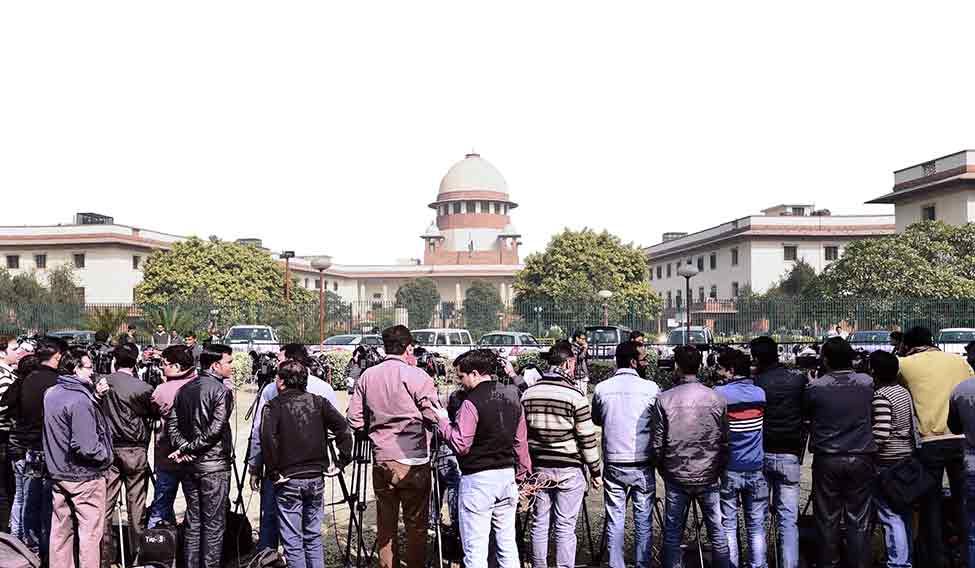Many legal experts were baffled when a Supreme Court bench headed by Justice J.S. Khehar, which had been on a mission to reform the collegium system for appointment, promotion and transfer of judges in the apex court and 24 High Courts, asked Attorney General Mukul Rohatgi to draft a new Memorandum of Procedure (MoP) for the collegium. “We will mine our minds together,” said Justice Khehar when the court heard the matter last November, a month after the National Judicial Appointments Commission (NJAC) was struck down.
Rohatgi was initially reluctant, saying it was not possible for the government to do it, and wondered whether a five-judge bench could ask the government to improve upon what was put in place as a result of the verdict of a nine-judge bench in 1998. But, he later said the government would draft the MoP. Senior advocate Gopal Subramaniam, however, made entreaties to the bench to “politely decline” the government’s offer as it would open the door for the executive to interfere with judicial independence.

Seven months later, Subramaniam can claim he stands vindicated. The collegium has sent back the new MoP drafted by the government, rejecting several clauses in it as they impinged upon the independence of the judiciary and were against the spirit of the judgment on the NJAC. This has set the stage for a new round of confrontation between the judiciary and the executive. The five-member collegium, comprising the Chief Justice of India and four senior-most judges of the Supreme Court, sent back the draft MoP on May 30, and the clauses it is understood to have opposed include the provision that the government can reject a recommendation citing “national interest” and “national security”. It is said that as per the draft MoP, once the government has turned down a recommendation, it will not be bound to reconsider it if the collegium sends it again. Also, the collegium is learnt to have rejected the clause that allows the attorney general at the Centre and the advocate general in the states to recommend candidates to the collegium.
The role of a secretariat proposed in the MoP to aid and assist the collegium also did not find favour with the judiciary. The apex court, in the guidelines that it laid down for the drafting of the new MoP, had wanted the role of the secretariat to be limited to collecting data about the candidates and not to prepare a shortlist by screening prospective names.
The collegium in its response while rejecting certain clauses is learnt to have said that these were “not in harmony” with the basic Constitutional requirement of independence of judiciary. It is felt that the government, through the draft MoP, has provided for itself a role in the selection of judges and has also reserved the right to veto a name by raising issues of national security and merit.
“Whatever government is doing now is basically the reaction coming from the government to do through the MoP what it could not do through the NJAC,” said Prof Faizan Mustafa, vice chancellor of National Academy of Legal Studies and Research, Hyderabad. “By bringing in merit, the intention is to reduce the importance of seniority. The government is interested in getting some discretion in judicial appointments. This discretion, if it is to be exercised by the executive after the recommendations made by the collegium, will seriously undermine judicial independence.”
There are apprehensions that by creating a controversy over the MoP, the government is either preparing to come up with a presidential reference on the MoP or getting ready to come up with another law. The Modi government has sent back three recommendations of the collegium. In the latest one, the government is learnt to have sent back a recommendation for a second time—the first time ever a reiteration of a name by the collegium was returned. Sources said the recommendation was for an acting chief justice of a High Court in an important opposition-ruled state to be elevated as chief justice.
Former Supreme Court judge K.S. Radhakrishnan said if the MoP was against the spirit of the judgment of the Supreme Court on the NJAC, there was no question of the collegium accepting it. “The collegium cannot accept it as it would also then be in contempt of court,” he said. An option before the government, he said, would be to refer the MoP to the five-judge bench which adjudicated on the NJAC. But this could lead to the matter getting referred to a nine-member Constitution bench, a situation that the government would want to avoid as of now.
Additional Solicitor General Pinky Anand said a modification of the existing system was the need of the hour to bring in transparency in judicial recruitment and promotions. She wanted the government to have a bigger role in appointment of judges. “It has to be part of the general process of discussion. The Constitution gave primacy to the executive in judicial appointments. This was changed by judicial interpretation,” she said.
Could the judiciary have taken a different route on the issue of MoP? “They should have themselves in their judicial order indicated provisions for the MoP. On the contrary, in an unprecedented move the Supreme Court first invited suggestions from the public and then asked the attorney general to come up with a draft MoP. He initially said no, and then the government saw an opportunity in it to reclaim the lost ground,” said Mustafa.
A response on the draft MoP to the collegium is unlikely to be sent before July. Rohatgi, who had an important role in the drafting of the MoP, will now draft a rebuttal to the collegium’s objections, and it would then be finalised by a group of ministers headed by External Affairs Minister Sushma Swaraj.







